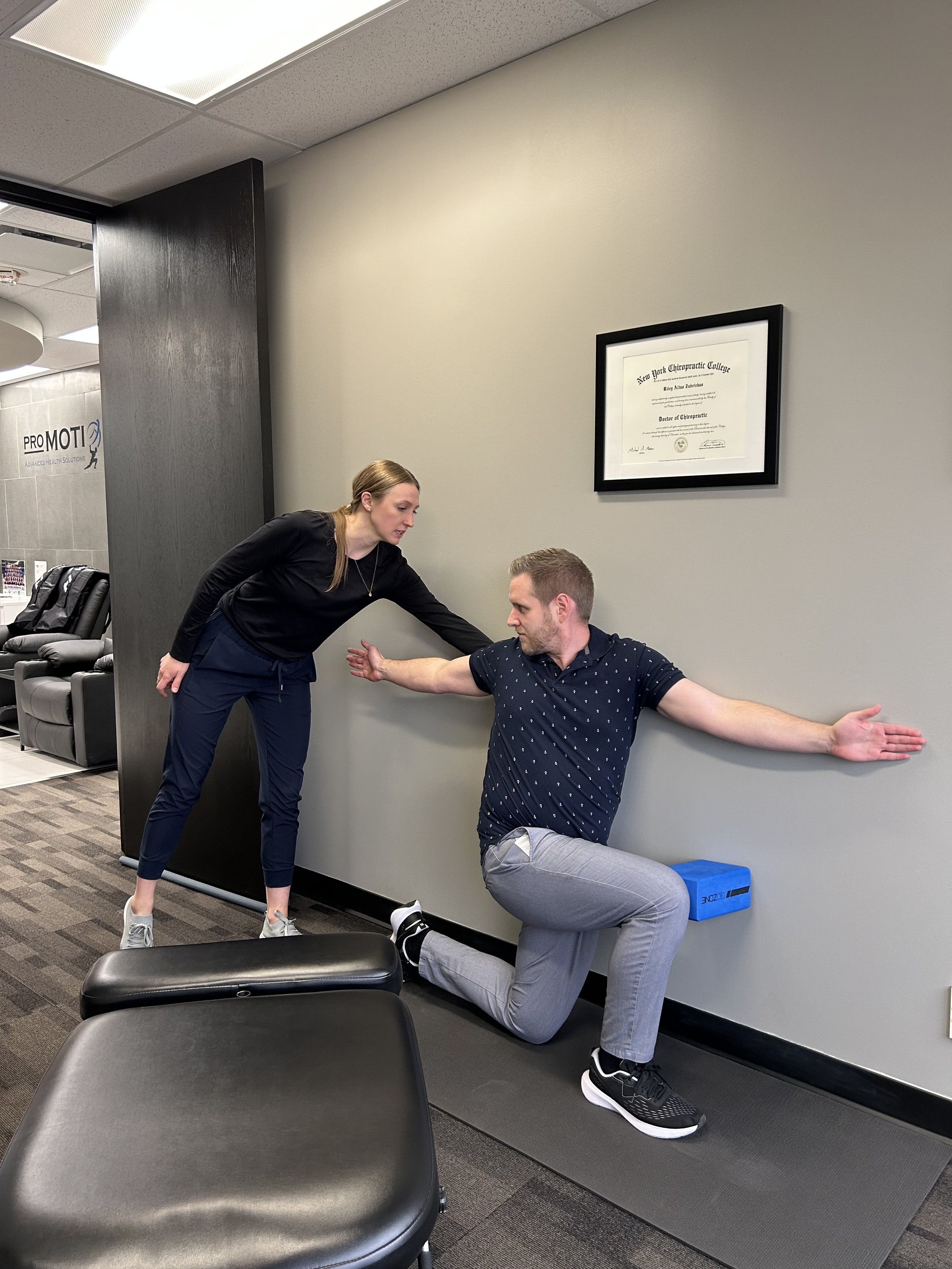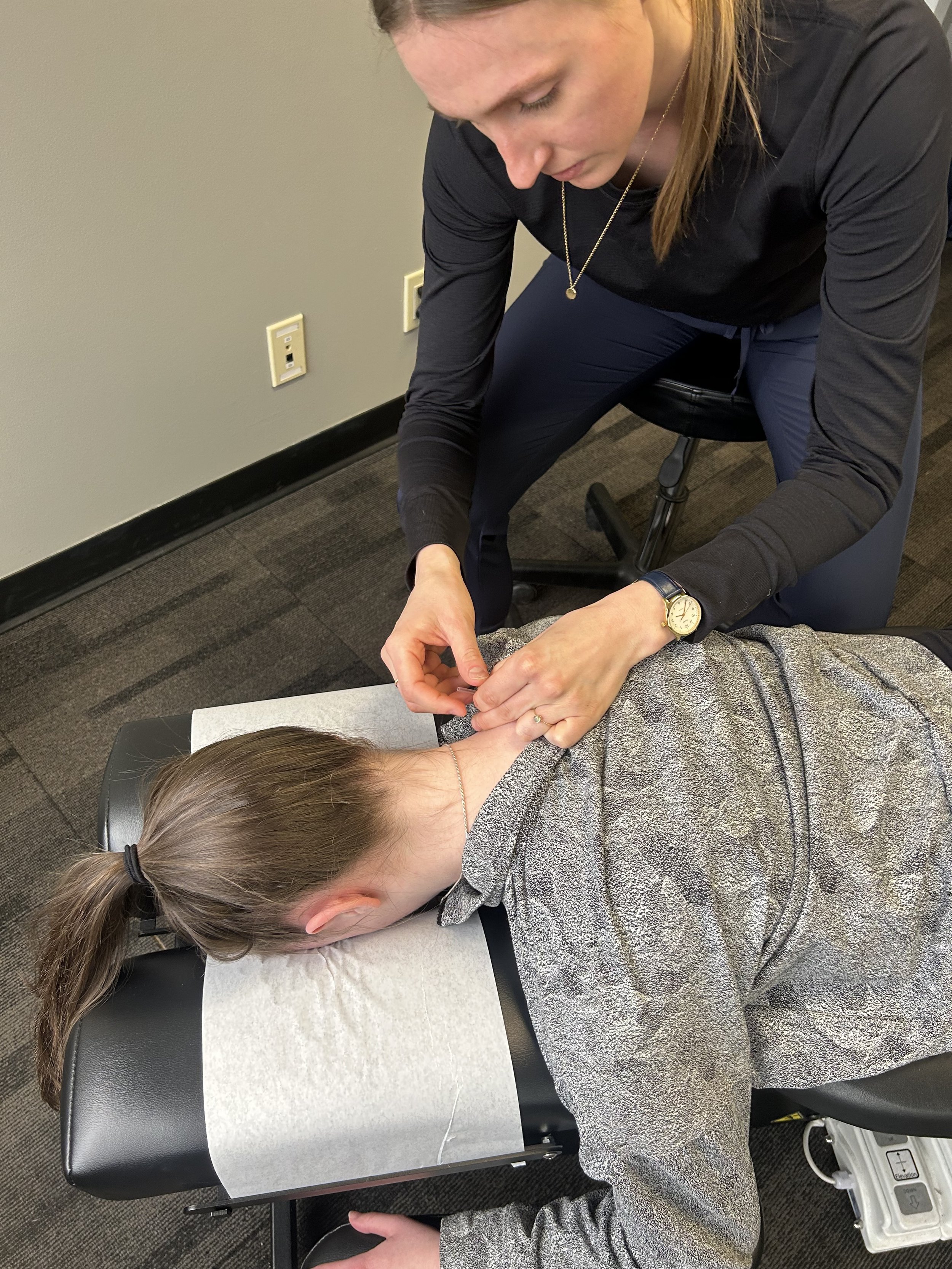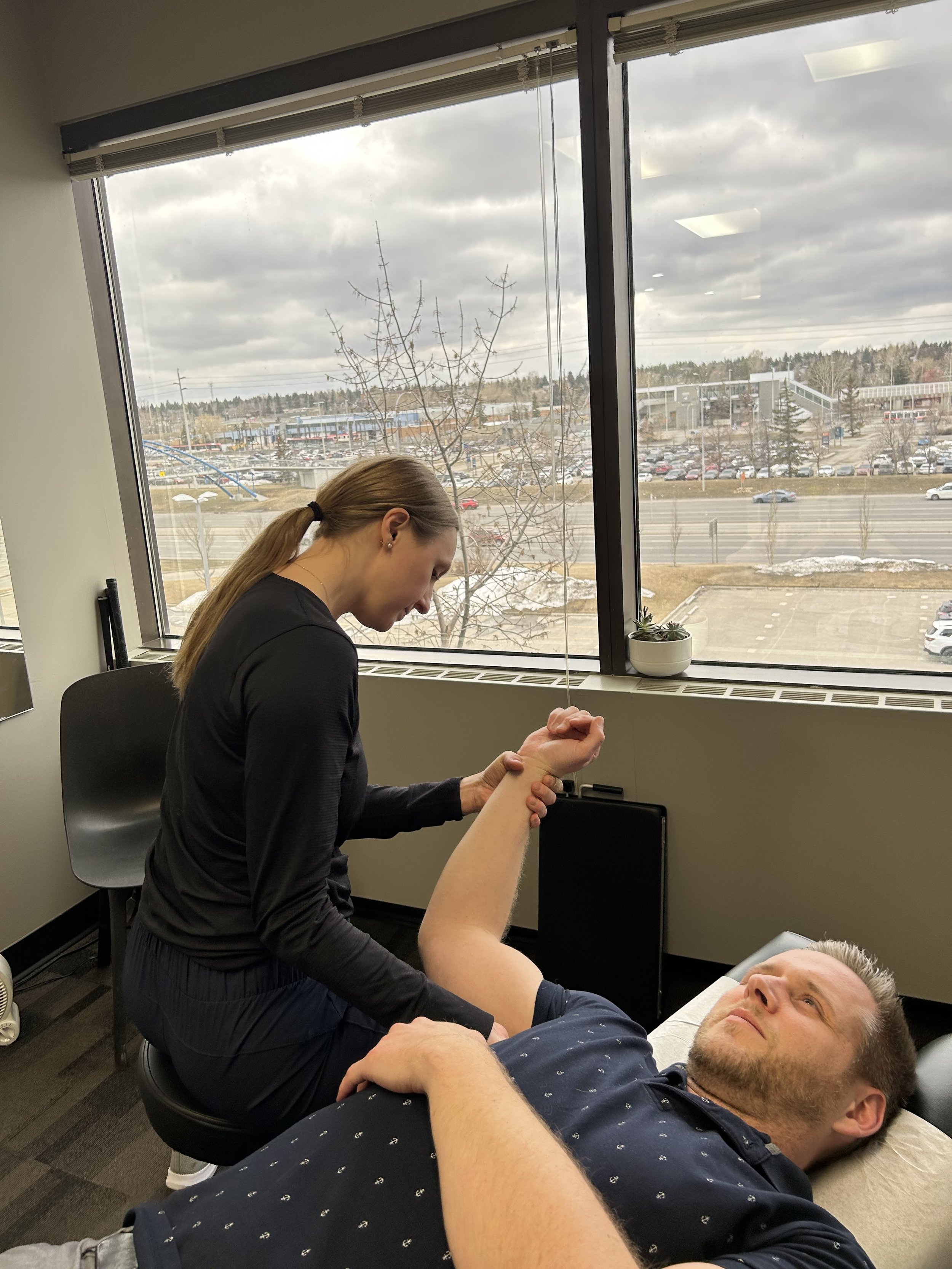Calgary Chiropractors
“There is a vast difference between treating the effects and adjusting the cause. ”
Our chiropractors take a multidisciplinary approach to treat our patients. They also have an extensive knowledge of sports and sports-related injuries. This means that they’re uniquely qualified to diagnose and treat an athlete’s body without the use of drugs or invasive surgical procedures. Because chiropractic medicine is defined by its hands on approach to treatment and sport-specific knowledge that addresses acute, chronic and overuse injuries, it’s becoming an increasingly popular way to stay in the game.
Whether you're an avid athlete or weekend warrior, baby boomer or mom working hard to keep up with her little ones, chiropractic care will enhance your ability to do what matters most to you. By identifying the root cause of an injury or condition- our doctors can effectively treat any issue. Our focus is taking you beyond corrective care, allowing you to access optimal health and new levels of performance. We don't want to treat you for the same issue over and over again - we want to see you grow, progress and thrive.
Our doctors love treating patients who are motivated to participate in their journey to elevate and maintain their health. We're family-friendly and inclusive; whether we're helping children through their growth spurts and ever-changing developmental stages or supporting parents who're getting their bodies back in motion to live pain free, we feel grateful to play a role in each family member's health. Ultimately, this treatment can benefit any and every body. Going beyond the confines of traditional chiropractic care, you can trust that when you choose our team of doctors, you're getting the best care out there.
In addition, our chiropractic clinic is conveniently located in the Southcentre Executive Tower, next to Southcentre Mall, with easy accessibility, and free parking. Our clinic also features a team of massage therapists that can, when coupled with chiropractic treatment, can lead to immediate pain relief and long term results.
Our Team:
Dr. Sadiq Rajan
Dr. Sadiq’s treatment consists of chiropractic care through the use of manual therapy, acupuncture using a Traditional Chinese Medicine approach, Functional Dry Needling, rehabilitation and corrective exercises, as well as healthy lifestyle choices through patient education and mindfulness techniques.
Calgary Chiropractor Dr. Jamie Jeffs
Dr. Jamie Jeffs (Haroldson)
Dr. Jamie is currently on maternity leave
Jamie’s time as a kinesiologist informed her active approach to care, providing her with the experience to understand and address pain from its foundation in movement. In her practice she focuses on optimizing movement and building resilience to pain or injury. Her intention with your care is to understand your individual movement and lifestyle goals and work with you to develop a plan that will allow you to enjoy and excel at the meaningful activities in your life. Depending on your presentation, her treatment may include education, spinal and extremity manipulation or mobilization, soft tissue therapy, acupuncture or dry needling, and exercise.
Frequently asked questions about Chiropractors:
-
Yes, chiropractors can help with sciatica, depending on the underlying cause and severity of the condition.
Sciatica refers to pain caused by irritation or compression of the sciatic nerve, often due to a herniated disc, spinal stenosis, or muscle tension (like piriformis syndrome). Chiropractors use non-invasive techniques to reduce pressure on the nerve, improve spinal alignment, and restore mobility.
Common chiropractic treatments for sciatica include:
Spinal adjustments to relieve nerve pressure
Soft tissue therapy for tight muscles and inflammation
Stretching and exercise programs to improve posture and prevent recurrence
Postural and lifestyle advice to support long-term recovery
-
Yes, chiropractors can help manage scoliosis, but their role is typically supportive rather than corrective—especially in adults or in more severe cases.
Scoliosis is a condition where the spine curves abnormally to the side. While chiropractic care won’t reverse the curvature, it can help reduce pain, improve mobility, and support overall spinal function.
How chiropractors may help with scoliosis:
Gentle spinal adjustments to reduce tension and improve alignment
Soft tissue therapy to ease muscle imbalances and discomfort
Postural exercises to strengthen supporting muscles
Pain management strategies to improve quality of life
-
Yes, chiropractors can help with certain types of knee pain, especially when it’s related to joint alignment, muscle imbalances, or referred pain from the hips, pelvis, or lower back.
While chiropractors don’t replace orthopedic specialists for serious structural damage (like a torn ACL), they can be very effective in reducing inflammation, improving joint mechanics, and supporting mobility.
How chiropractors help with knee pain:
Joint adjustments to the knee, hip, or spine to improve movement patterns
Soft tissue therapy to reduce muscle tension and inflammation
Rehabilitative exercises to strengthen supportive muscles
Postural and gait assessments to identify and correct contributing issues
Common conditions chiropractors treat:
Patellofemoral pain syndrome (runner’s knee)
Osteoarthritis-related knee pain
Meniscus irritation (non-surgical cases)
Referred pain from the lower back or hips
-
Yes, chiropractors can help with certain types of vertigo, particularly when it’s caused by issues in the neck or inner ear—like cervicogenic vertigo or benign paroxysmal positional vertigo (BPPV).
How chiropractors may help with vertigo:
Spinal adjustments to the neck (cervical spine) to relieve nerve interference and improve balance
Canalith repositioning maneuvers (like the Epley maneuver) to treat BPPV by realigning calcium crystals in the inner ear
Balance and vestibular exercises to support the body’s equilibrium
Soft tissue work to reduce tension in the neck that may contribute to dizziness
Chiropractors are most effective when vertigo is related to:
Neck injuries or tension (whiplash, poor posture, etc.)
Inner ear disturbances like BPPV
Joint misalignments affecting balance signals
-
Yes, chiropractors can help with pinched nerves, especially when the cause is related to spinal misalignment, disc issues, or muscle tension putting pressure on nearby nerves.
A "pinched nerve" (also called nerve impingement or compression) often results in pain, tingling, numbness, or weakness, commonly in the neck, back, arms, or legs. Chiropractic care offers non-invasive, drug-free relief by addressing the root cause of the compression.
How chiropractors help with pinched nerves:
Spinal adjustments to realign vertebrae and relieve nerve pressure
Soft tissue therapy to reduce muscle tension around the nerve
Stretching and strengthening exercises to improve posture and support long-term healing
Lifestyle and ergonomic advice to prevent future flare-ups
Common conditions involving pinched nerves:
Herniated or bulging discs
Sciatica (compressed sciatic nerve)
Cervical radiculopathy (nerve compression in the neck)
Thoracic outlet syndrome
-
In Canada, chiropractors are regulated healthcare professionals, but they are not medical doctors (MDs).
Here’s what that means:
Chiropractors in Canada earn a Doctor of Chiropractic (DC) degree after completing a minimum of 7–8 years of post-secondary education, including a specialized 4-year chiropractic program.
They are licensed and regulated by provincial chiropractic colleges (e.g., Alberta College and Association of Chiropractors).
Chiropractors are considered primary contact practitioners, meaning you do not need a referral to see one.
They are trained to assess, diagnose, and treat musculoskeletal conditions, with a strong emphasis on spine, joints, muscles, and nervous system health.
Key differences from MDs:
Chiropractors do not prescribe medication or perform surgery.
Their approach is non-invasive and drug-free, often focusing on manual therapies, exercise, and lifestyle advice.
So while they hold the title “Doctor” based on their degree, they are not medical doctors, but are highly trained specialists in musculoskeletal care.
-
Chiropractors treat back pain using non-invasive, hands-on techniques aimed at relieving pressure, improving spinal function, and promoting natural healing.
Common chiropractic treatments for back pain include:
1. Spinal Adjustments (Manipulation)
Realigns vertebrae to reduce nerve irritation and restore joint mobility
Often provides immediate relief and improves range of motion
2. Soft Tissue Therapy
Massage, trigger point release, or instrument-assisted techniques to reduce muscle tension and inflammation
3. Stretching & Strengthening Exercises
Customized exercises to support posture, core stability, and long-term recovery
4. Postural and Ergonomic Advice
Guidance on sitting, sleeping, and working positions to prevent recurring back pain
5. Lifestyle & Activity Modifications
Education on movement patterns, daily habits, and injury prevention
Chiropractic care is especially effective for:
Mechanical lower back pain
Muscle strains and spasms
Joint dysfunction
Disc-related irritation (non-severe herniations)
Chronic postural stress
-
Yes, you can see a chiropractor while pregnant, and many women find chiropractic care helpful for managing the physical changes and discomforts of pregnancy.
Chiropractic care during pregnancy can help:
Relieve lower back pain, hip pain, and pelvic discomfort
Improve posture and alignment as your body adapts to carrying extra weight
Support pelvic balance, which may contribute to smoother labor and delivery
Reduce tension and stress through gentle, safe manual techniques
Chiropractors trained in prenatal care:
Use gentle, pregnancy-safe techniques
Avoid pressure on the abdomen
May use specialized pregnancy pillows or tables
Often work in coordination with obstetric care providers
Common issues treated:
Sciatica or nerve pain
Round ligament pain
Postural strain
Pubic symphysis pain (pelvic instability)
Always ensure your chiropractor is experienced in prenatal care, and speak with your OB or midwife if you have a high-risk pregnancy or medical concerns.
-
No, chiropractors are not physiotherapists—they are two distinct healthcare professions, though they sometimes treat similar conditions like back pain, joint problems, or sports injuries.
Key differences:
Chiropractors
Hold a Doctor of Chiropractic (DC) degree
Focus on spinal health, joint alignment, and nervous system function
Use manual adjustments, spinal manipulation, and lifestyle advice
Often emphasize non-invasive, drug-free care centered on spinal mechanics
Physiotherapists (Physical Therapists)
Hold a Master’s or Doctorate in Physiotherapy
Focus on rehabilitation, movement science, and functional recovery
Use a wide range of techniques including manual therapy, exercise therapy, electrotherapy, and education
Often work post-injury or post-surgery to restore strength and mobility
Can they work together?
Yes. Many clinics offer integrated care, where chiropractors and physiotherapists collaborate to provide the most effective treatment plan for a patient.
You’re one chiropractic adjustment away from a great day! Book today, feel better tomorrow!

















